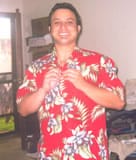
Branden Bonilla was born and raised in Kapaa on the island of Kauai. Currently, he is an Electronics Technology student at Kauai Community College. He is excited about his internship on the Big Island which will give him hands on experience in real life situations. Branden enjoys hanging out at the beach (bodyboarding, fishing and camping), hitting the gym, listening to music and playing video games.
Home Island: Kauai
Institution when accepted: Kauai Community College
Akamai Project: Cold Head Remote Control
Project Site: Academia Sinica Institute of Astronomy and Astrophysics
Mentors: Derek Kubo, Pablo Altamarino
The AMiBA (Array for Microwave Background Anisotropy) Telescope collects microwave signals using seven input receivers. The receivers perform at their peak when they are cooled to about 10-18 degrees Kelvin. The AMiBA Telescope uses a series of switches and relays combined in one unit, called a split-box to activate cryogenic refrigerator devices called cold heads. Cold heads and a vacuum are used to create an airless environment within the AMiBA’s input receivers to keep them operating at the optimal temperature. The current system can only be turned on manually at the AMiBA Telescope located on Mauna Loa, about 11,000ft above sea level. My project is to install two devices that will act as a remote control for the cold head system, allowing AMiBA staff to turn on the cold heads from their headquarters in Hilo. The two devices are called the ADAM 5000/TCP, which is the main hardware unit and a complimentary module called the ADAM 5068, which contains eight relay switches, seven of which are used to control each of the cold heads for the seven receivers. These devices can be controlled from Hilo through an Ethernet-connected network that the AMiBA team is already using. There are two specific cases where this modification will be very beneficial: first, resetting the cold heads, as the input receivers will warm up over time due to an imperfect vacuum environment, and second, turning the cold heads back on after power outages. In both of these cases, the remote control set up will reduce a lot of down time and wasted resources since the cold heads can now be reset without traveling to Mauna Loa. The end result is an increase in the operation efficiency for the AMiBA telescope.